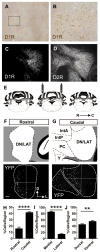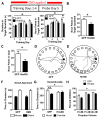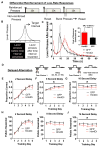Dopamine D1 Receptor-Positive Neurons in the Lateral Nucleus of the Cerebellum Contribute to Cognitive Behavior
- PMID: 29478701
- PMCID: PMC6072628
- DOI: 10.1016/j.biopsych.2018.01.019
Dopamine D1 Receptor-Positive Neurons in the Lateral Nucleus of the Cerebellum Contribute to Cognitive Behavior
Abstract
Background: Studies in humans and nonhuman primates have identified a region of the dentate nucleus of the cerebellum, or the lateral cerebellar nucleus (LCN) in rodents, activated during performance of cognitive tasks involving complex spatial and sequential planning. Whether such a subdivision exists in rodents is not known. Dopamine and its receptors, which are implicated in cognitive function, are present in the cerebellar nuclei, but their function is unknown.
Methods: Using viral and genetic strategies in mice, we examined cellular phenotypes of dopamine D1 receptor-positive (D1R+) cells in the LCN with whole-cell patch clamp recordings, messenger RNA profiling, and immunohistochemistry to examine D1R expression in mouse LCN and human dentate nucleus of the cerebellum. We used chemogenetics to inhibit D1R+ neurons and examined behaviors including spatial navigation, social recognition memory, prepulse inhibition of the acoustic startle reflex, response inhibition, and working memory to test the necessity of these neurons in these behaviors.
Results: We identified a population of D1R+ neurons that are localized to an anatomically distinct region of the LCN. We also observed D1R+ neurons in human dentate nucleus of the cerebellum, which suggests an evolutionarily conserved population of dopamine-receptive neurons in this region. The genetic, electrophysiological, and anatomical profile of mouse D1R neurons is consistent with a heterogeneous population of gamma-aminobutyric acidergic, and to a lesser extent glutamatergic, cell types. Selective inhibition of D1R+ LCN neurons impairs spatial navigation memory, response inhibition, working memory, and prepulse inhibition of the acoustic startle reflex.
Conclusions: Collectively, these data demonstrate a functional link between genetically distinct neurons in the LCN and cognitive behaviors.
Keywords: Cerebellar nuclei; Cerebellum; Cognition; DREADD receptor; Dopamine D(1) receptor; RiboTag.
Copyright © 2018 Society of Biological Psychiatry. Published by Elsevier Inc. All rights reserved.
Figures






Similar articles
-
Catecholaminergic Innervation of the Lateral Nucleus of the Cerebellum Modulates Cognitive Behaviors.J Neurosci. 2021 Apr 14;41(15):3512-3530. doi: 10.1523/JNEUROSCI.2406-20.2021. Epub 2021 Feb 3. J Neurosci. 2021. PMID: 33536201 Free PMC article.
-
Deletion of the NMDA-NR1 receptor subunit gene in the mouse nucleus accumbens attenuates apomorphine-induced dopamine D1 receptor trafficking and acoustic startle behavior.Synapse. 2013 Jun;67(6):265-79. doi: 10.1002/syn.21637. Epub 2013 Mar 5. Synapse. 2013. PMID: 23345061 Free PMC article.
-
Nucleus accumbens controls wakefulness by a subpopulation of neurons expressing dopamine D1 receptors.Nat Commun. 2018 Apr 20;9(1):1576. doi: 10.1038/s41467-018-03889-3. Nat Commun. 2018. PMID: 29679009 Free PMC article.
-
Dopamine D1-receptor-expressing pathway from the nucleus accumbens to ventral pallidum-mediated sevoflurane anesthesia in mice.CNS Neurosci Ther. 2023 Nov;29(11):3364-3377. doi: 10.1111/cns.14267. Epub 2023 May 19. CNS Neurosci Ther. 2023. PMID: 37208941 Free PMC article.
-
Dimerization of dopamine D1 and D3 receptors in the regulation of striatal function.Curr Opin Pharmacol. 2010 Feb;10(1):87-92. doi: 10.1016/j.coph.2009.09.008. Epub 2009 Oct 17. Curr Opin Pharmacol. 2010. PMID: 19837631 Review.
Cited by
-
Reverse-translational identification of a cerebellar satiation network.Nature. 2021 Dec;600(7888):269-273. doi: 10.1038/s41586-021-04143-5. Epub 2021 Nov 17. Nature. 2021. PMID: 34789878 Free PMC article.
-
Cerebellar contributions across behavioural timescales: a review from the perspective of cerebro-cerebellar interactions.Front Syst Neurosci. 2023 Sep 7;17:1211530. doi: 10.3389/fnsys.2023.1211530. eCollection 2023. Front Syst Neurosci. 2023. PMID: 37745783 Free PMC article. Review.
-
Fitness-Dependent Effect of Acute Aerobic Exercise on Executive Function.Front Physiol. 2019 Jul 10;10:902. doi: 10.3389/fphys.2019.00902. eCollection 2019. Front Physiol. 2019. PMID: 31354533 Free PMC article.
-
Catecholaminergic Innervation of the Lateral Nucleus of the Cerebellum Modulates Cognitive Behaviors.J Neurosci. 2021 Apr 14;41(15):3512-3530. doi: 10.1523/JNEUROSCI.2406-20.2021. Epub 2021 Feb 3. J Neurosci. 2021. PMID: 33536201 Free PMC article.
-
Sex-Associated Cerebellar and Hippocampal Volume Reduction in Alzheimer's Disease: Insights from the Clinical ADNI Cohort and STZ Animal Model.Int J Mol Sci. 2025 May 17;26(10):4810. doi: 10.3390/ijms26104810. Int J Mol Sci. 2025. PMID: 40429951 Free PMC article.
References
-
- Kawato M, Gomi H. A computational model of four regions of the cerebellum based on feedback-error learning. Biological cybernetics. 1992;68:95–103. - PubMed
-
- Medina JF, Nores WL, Ohyama T, Mauk MD. Mechanisms of cerebellar learning suggested by eyelid conditioning. Current opinion in neurobiology. 2000;10:717–724. - PubMed
-
- Braak E, Arai K, Braak H. Cerebellar involvement in Pick’s disease: affliction of mossy fibers, monodendritic brush cells, and dentate projection neurons. Experimental neurology. 1999;159:153–163. - PubMed
Publication types
MeSH terms
Substances
Grants and funding
LinkOut - more resources
Full Text Sources
Other Literature Sources
Miscellaneous

